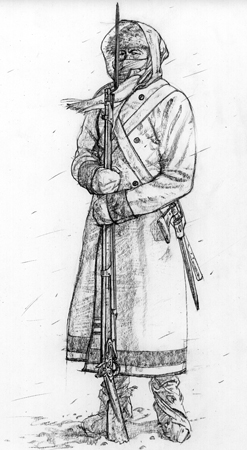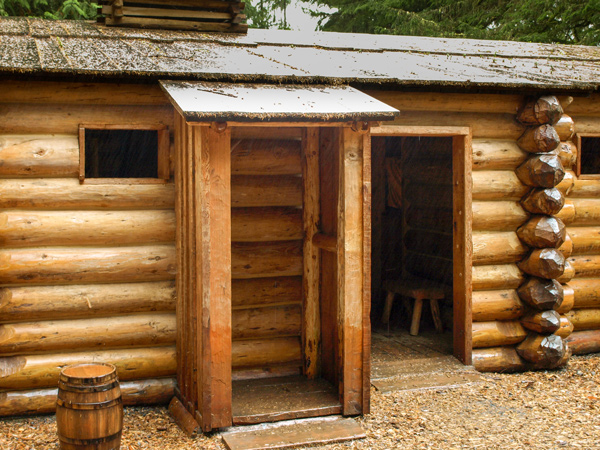Fort Mandan Guard
© Michael Haynes, https://www.mhaynesart.com. Used with permission.
Types of Guards
Steuben’s Regulations listed four types of guards, and described their objectives and procedures. “Out post and piquet [picket] guards,” “Camp and quarter guards,” and “General and staff officers guards.”
- Picket guards were posted “at the avenues of the camp”
- Camp guards were to form a complete chain of sentinels around the camp “in order to prevent improper persons entering, or the soldiers going out of camp.” Camp guards were responsible for protecting the camp from intruders, and preventing soldiers from leaving camp without authorization.
- Quarter guards were small units situated in front of each battalion; their main duty was to ensure good order and discipline in the camp.
- Officers’ guards were honorary details mustered according to rank for officers higher than captain.
Sentinel Box
Fort Clatsop (replica)
Photo © 2008 by Kristopher K. Townsend. Permission to use granted under the Creative Commons Attribution-Share Alike 4.0 International license.
The Captains’ Detachment Orders
Lewis and Clark’s detachment was too small to either require or permit such elaborate security systems. During their journey up the Missouri to the Knife River Villages, security procedures were outlined in the detachment orders of 26 May 1804. One of their three sergeants was to be stationed at the helm of the keelboat, another at the bow, and the third in the center, revolving their positions during “parade” every morning. Each position entailed specific duties. The center man was nominally sergeant of the guard, but he had other responsibilities as well. He was to:
manage the sails, see that the men at the oars do their duty; that they come on board at a proper [time] in the morning, and that the boat gets under way in due time; he will keep a good lookout for the mouths of all rivers, creeks, Islands and other remarkable places and shall immediately report the same to the commanding officers; he will attend to the issues of sperituous liquors; he shall regulate the halting of the batteaux [the keelboat] through the day to give the men refreshment [rest], and will also regulate the time of her departure taking care that not more time than is necessary shall be expended at each halt—
The sergeant of the guard’s instructions concerning camp security were specific to the Corps, but were generally consistent with Steuben’s. This sergeant’s detail consisted of “six privates & engages [engagés]” who relieved one another on an hourly basis:
it shall be his duty also to post a centinel on the bank, near the boat whenever we come too and halt in the course of the day, at the same time he will (acompanied by two his guard) reconnoiter the forrest arround the place of landing to the distance of at least one hundred paces. when we come too for the purpose of encamping at night, the Sergt. of the guard shall post two centinels immediately on our landing; one of whom shal be posted near the boat, and the other at a convenient distance in rear of the encampment; at night the Sergt. must be always present with his guard, and he is positively forbidden to suffer any man of his guard to absent himself on any pretext whatever; he will at each relief through the night, accompanyed by the two men last off their posts, reconnoiter in every direction around the camp to the distance of at least one hundred and fifty paces, and also examine the situation of the boat and perogues, and see that they ly safe and free from the bank—
These orders concerning camp security were never officially modified or rescinded, so we may assume they were followed throughout the expedition. The need for continual vigilance must have been apparent to every man, all the more as they progressed up the Missouri into regions known to be occupied by potentially hostile tribes. The hunters who ranged far from the river, and often ahead of the boats, served also as scouts; Sergeants Ordway and Floyd even referred to as “flanking” parties. Modifications of procedures would have been made only as necessary and prudent, given changing circumstances. Clark, responding to a Sioux threat at Fort Mandan with a 21-man detachment under his command, deployed flanking parties on each side, as well as a rear guard. During extended overland travel, sentries would also have kept track of the horses, as far as possible.
Further Adaptations
The sergeant at the bow of the keelboat was to “keep a good look out for all danger which may approach, either of the enimy, or obstructions which may present themselves to . . . passage of the boat.” Also, he was to report all other boats that came in sight, and all camps or parties of Indians in view, to the sergeant at the center, who would relay it to the commanding officers. Obstructions were to be reported direct to the sergeant at the helm. Each sergeant was to keep a separate daily journal “of all passing occurences, and such other observations on the country &c. as shall appear to them worthy of notice.” Those special journals have not been found.
No special orders concerning security were issued at Fort Mandan. However, the Canadian trader François-Antoine Larocque, who was there for several weeks that winter, recorded that a sentry was posted atop the storeroom every night, and “a Centinel [was] likewise kept all day, walking in the Fort.”[1]“François-Antoine Larocque’s ‘Missouri Journal’,” in W. Raymond Wood and Thomas D. Thiessen, Early Fur Trade on the Northern Plains (Norman, University of Oklahoma … Continue reading The last detachment orders in the Orderly Book, setting forth procedures for the security of Fort Clatsop, were issued on 1 January 1806.
Notes
| ↑1 | “François-Antoine Larocque’s ‘Missouri Journal’,” in W. Raymond Wood and Thomas D. Thiessen, Early Fur Trade on the Northern Plains (Norman, University of Oklahoma Press, 1985), 143. |
|---|


